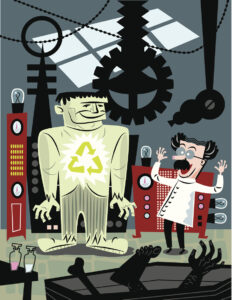No one need ask why the strict public health regime to manage Covid — masks, mandates, quarantines, and required inoculations — has begun to collapse. Between angry truckers, unfavorable polling for continued lockdowns, the perception of a Wuhan coverup, changing reports of vaccine effectiveness, and declining hospitalizations, even President Biden and blue state governors realize they have but two options: pretend to be leading a return to normalcy or face an unpredictable grassroots rebellion.
The interesting question for Americans is not why the sudden prospect of a return to normalcy but what “returning to normalcy” really means.
For even though any government effort to resume strict lockdowns would be fiercely resisted, a substantial minority — especially the elderly, the obese, the immunocompromised, and others disproportionately vulnerable to the coronavirus — will remain cautious, regardless of any all-clear. At the same time, the public’s response to many of the policies enacted to manage the pandemic has created unexpected preferences which promise to radically alter how the US functions going forward.
The most obvious of these preferences is the desire to work from home. Not only do those who were prevented from going to the office by Covid lockdowns insist they have become more productive, but research from Owl labs shows that remote workers are 22 percent happier than onsite employees. Those who work from home experience less stress and report a more satisfying work-life balance.
Once more, a growing number of employers seem to be comfortable with the idea of, if not letting staff work from home all the time, at least having their people come in less often. Kate Lister, president of Global Workplace Analytics, estimates that by 2025, nearly 70 percent of all employees will be working at home at least one business week every month. This will have lasting implications for everything from how families handle childcare to how people communicate in general.
Another post-Covid preference that promises major social change is the desire of parents to have more control over their children’s schooling. For some, creating alternatives to closed local schools — joining with neighbors to collaboratively homeschool in so-called “learning pods” or “micro-schools,” for example — turned out to be a surprisingly rewarding challenge. A poll taken by EdChoice during the first year of Covid found that many parents became far more comfortable with educating their own children than they had ever thought possible.
And for those parents whose children continued to take public school classes online, seeing how far woke pedagogy had penetrated the curriculum — even into math and science courses — proved deeply disturbing. Along with parents who were angry simply because many teacher unions had dragged out the resumption of in-person learning, they have become vocal advocates for government funding of private and parochial schools, private tutoring, and other K-12 alternatives.
“A couple of years ago, there was a feeling in the country that opposition to school choice was on the rise,” says Paul Peterson, director of Harvard University’s Program on Education Policy and Governance. “But in light of the pandemic…we are finding the passage of new school choice legislation in states across the country, new tax credit programs, new education savings accounts programs, expanded charter school programs.”
This growing parental desire to have more control over their children’s educations, combined with the newfound preference for working remotely, has produced a third social trend: a move away from cities toward suburbs and even exurbs. In a December 2021 study of how Covid had changed where people wished to live, the Pew Research Center found that only one in five American adults wanted to reside in a city, down from about a quarter in 2018. Over the same period, the share of Americans who preferred to make their home in the suburbs had increased by almost ten percent.
The outbreaks of urban violence inspired by the death of George Floyd, and the reluctance of progressive prosecutors in New York, Los Angeles, Philadelphia, and other cities to punish many types of crime, may well have happened in the absence of coronavirus, but they have clearly magnified the new anti-city animus. Chris Porter, a real estate consultant to homebuilders, says the growing aversion to urban cores is “unlike anything we’ve seen in decades. The closest comparison is the suburbanization we saw in the 1950s.”
These are the most obvious drivers of the “new normal,” but not the only ones. After two years of dubious pandemic policies — from the disruption of nearly every social institution to the enactment of inflationary “rescue” bills — voters’ faith in the competence of government has clearly declined. According to a recent Morning Consult/Politico poll, two thirds of Americans think the current political establishment has put their country on the wrong track.
Just as the Great Depression destroyed the electorate’s faith in free markets, putting pro-regulation and redistributionist Democrats in charge of Washington, Hudson Institute senior fellow Arthur Herman believes the US may even be on the verge of a complete political reversal. If, as in 1932, the party out of power eventually benefits from the public’s desire for radical change, coming Republican election victories could well end two decades of partisan wrangling with a definitive shift to the right.
Covid may even have created an unexpected mission for many of country’s houses of worship. In writing about the growth of homeschooling collaboratives during the pandemic, journalists understandably focused on the availability of online curricula and the extra time enjoyed by parents who were now working from home. But almost completely overlooked was the pivotal role played by churches.
“The unsung heroes [were] the pastors and church boards,” says Tina Hollenbeck, founder of the Homeschool Resources Roadmap, which reviews online curricula for families and small schools. For months, they provided the “spaces where kids [could] gather in small groups to learn with and alongside their parents and other adult leaders.”
Dr. Brian Ray, president of the National Home School Education Research Institute, agrees: “There’s no official data yet, but with so many parents looking for places to safely educate their children, the use of religious settings…clearly accelerated.”
Some observers, such as Arizona State University professor of African and European Christianity Andrew Barnes, think that the widespread clerical support of homeschooling collaboratives during Covid heralds an entirely new social function for organized religion — one that could even counter the problem of declining denominational affiliation. Noting that from the sixteenth century to the mid-1800s, churches were primary innovators of lay education, he says, “I can see that happening again.”
It was only natural during the two years of lockdowns and mandates that most people would equate their desire to once again be free with somehow resuming the life they had previously known. The good news is that Americans are indeed regaining their liberty, especially from the most arrogant, stubborn, and hypocritical officials. But while there is every reason to feel good about returning to the larger world, it is not the one we left.





